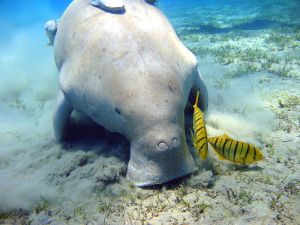We meet the dugongs and manatees, those mysterious marine mammals that were once mistaken for mermaids.
 Find out more:
Find out more:
West Indian Manatee, at the Florida Museum of Natural History
Sarah- Well, we've reached our Christmas critter number four, and I've chosen some gentle giants. The dugongs, and their close cousins the manatees.
These are the sirenians, a group of marine mammals that evolved from four legged ancestors that took to the sea around 50 million years ago and supposedly were mistaken by sailors for mermaids... hmmm... not sure about that, maybe they'd been at sea for way too long.
well, they have a host of adaptations to an aquatic life - they have very dense bones that act as ballast, and huge lungs that take up two thirds of their body length, which they use to control their buoyancy.
And they've earned themselves a reputation as the dummies of the marine mammal world, because their brains are only the size of a cricket ball - which in actual fact is probably an unfair label, because they can be trained to perform similar tasks as their more famously intelligent cousins, the dolphins.
It might be not so much that dugongs and manatees have tiny brains but that they have evolved super-sized bodies that keep them warm and provide enough space for a huge stomach to digest all the tough seagrass and vegetation they eat.
There are four living sirenian species - a single dugong species lives in the Indian and Pacific Oceans, there's the west African manatee, and the west Indian manatee that lives around the Caribbean, plus a third species that's evolved to tolerate freshwater in the Amazon river.
But there have been lots more sirenian species in the past - there are around 50 extinct fossil species known of, and one of the biggest was the Stellar's Sea cow. That one grew to a gigantic 8 metres in length and used to live across the North Pacific until people hunted them to extinction because they were just too tasty and being such slow, docile creatures they were too easy to catch.
Helen- And I guess not many people hunt manatees and dugongs today, but they do face various threats still, don't they?
Sarah - Yep, there are problems like getting hit by boats as well as habitat loss - they eat a lot of seagrass and other vegetation that's under threat globally. And then last winter, a lot of manatees in Florida died because the temperature plummeted - seems they are sensitive creatures.
和海伦,你知道如何区分between a dugong and a manatee?
Helen- It's their tails isn't it?
Sarah- Yeah, that's right - Manatees have a spoon shaped tail, while Dugongs have fluked tails more like a dolphin.
- PreviousSea Angels
- NextChampion migrant
 Find out more:
Find out more:






Comments
Add a comment